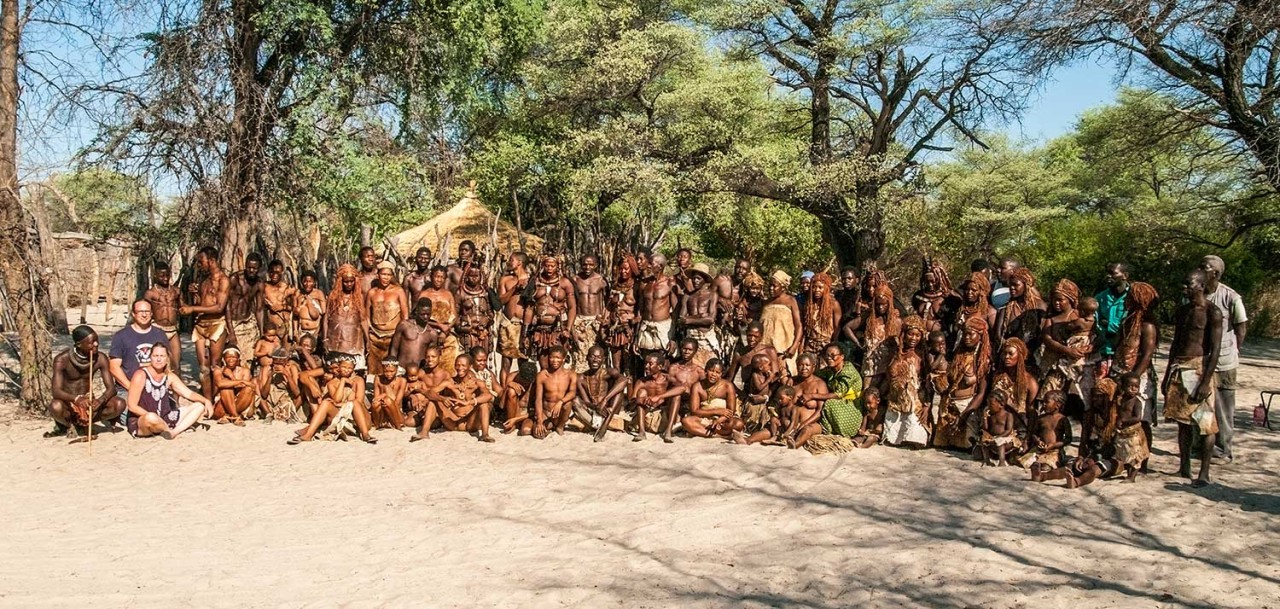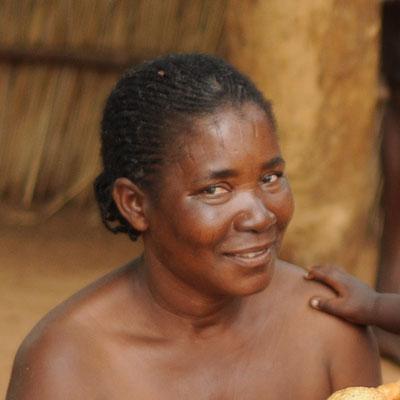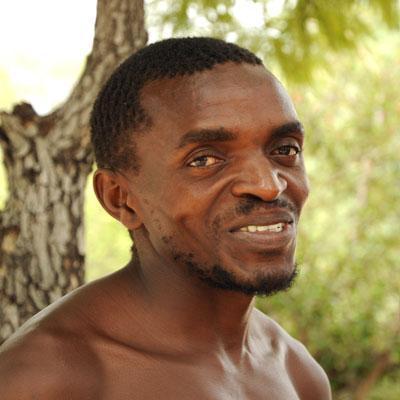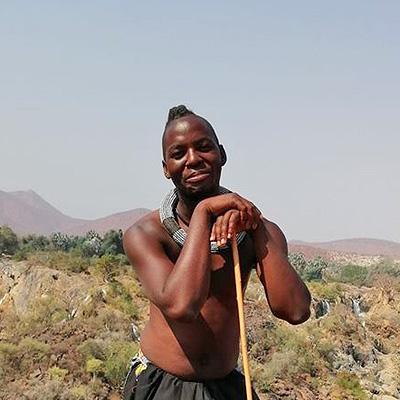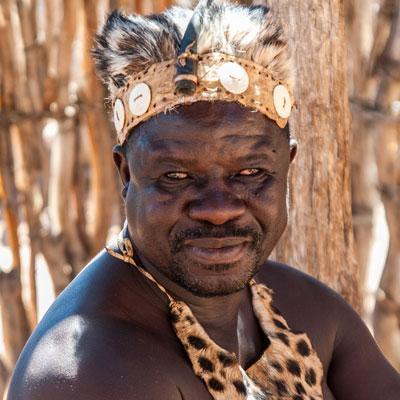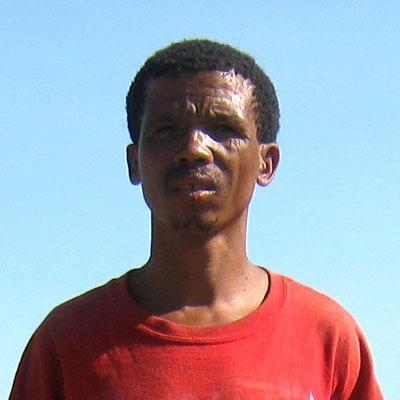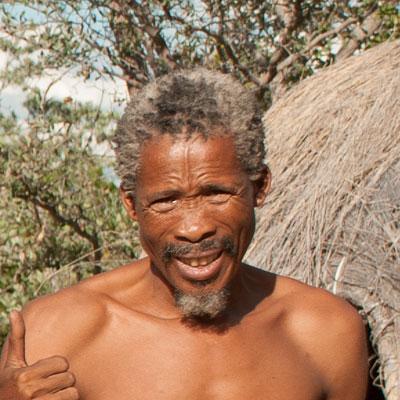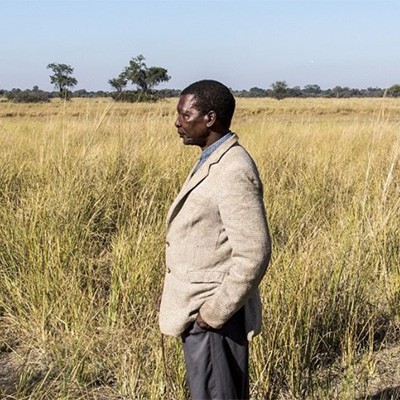Fascinating culture of the San
Traditional, intercultural workshop of all 7 living museums
During the last project tour, the idea of a traditional workshop at the Mbunza Living Museum came about. The aim of the workshop was to improve traditional craft techniques that originally played a role in the respective traditional cultures and are now demonstrated in the living museums, as well as to relearn lost techniques. Furthermore, the workshop should also contribute to intercultural exchange. It was the first time that members from all seven Living Museums came together.
October 24th - October 27th, 2023 – Preparation
The preparation and detailed planning of the traditional workshop took a lot of time. In advance of the actual workshop, we procured goat and impala skins for making clothing, clay for the pottery workshop, and 12 tents to accommodate the workshop participants. At the request of the Living Museums, we designed certificates for the workshop participants and had them printed. We bought food for the first few days and got wrought iron, tools, ostrich egg shells and much more.
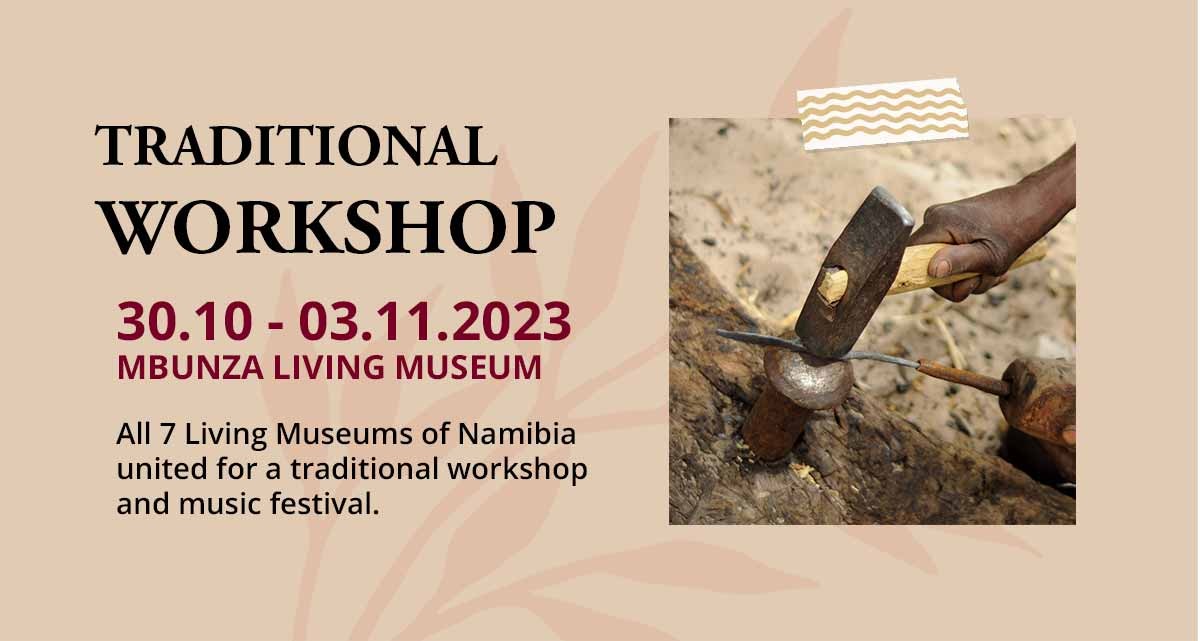
Saturday, October 28, 2023 – Arrival
We started in Windhoek in the morning and arrived in the late afternoon at our friend Andy Fudge in Camp Samsitu, who has already supported the Mbunza Living Museum several times with ideas and work. We set up our tent camp here.
Sunday, October 29th, 2023 - Arrival day of the workshop participants, on-site organization of the workshop
We arrived at the museum in the morning and discussed the following days with manager Sebron Ruben. We appointed him manager of the workshop, about which he was only partially happy. We also unloaded all the things we had brought with us.
After agreeing with Sebron, for the catering - one of the most important things of the workshop - we decided to obtain a cow. Sebron also gave us a list of food items that we should get in Rundu.
We showed the Mbunza how to pitch their tents and during the day a beautiful tent camp was set up in the eastern part of the Living Museum.
We then drove to Rundu and got the things we still needed (onions, cabbage, carrots, etc. - plus charcoal for the blacksmith workshop). After shopping, we drove back on the B8 towards Grootfontein and picked up 2 trainers (Magdalena Siweka for the pottery workshop and Elias Albert for the woodcarving workshop), who worked with us in the workshop for the following 6 days and whose job it was to bring the museum people a little closer to their masterful skills.
Back at the Living Museum, the first people (Khwe and Ju/‘Hoansi from the Living Hunter’s Museum had arrived) and we were warmly welcomed. As the day progressed, the other workshop participants arrived, the taxi drivers were paid and people moved into their tents. Shortly after nightfall, the Ju/‘Hoansi from Grashoek and Ovahimba also made it.
In the late afternoon the cow for catering brought. It was caught with our tow rope in Angola, dragged through the Okavango River and slaughtered there in the Damara style; not necessarily something for the faint of heart.
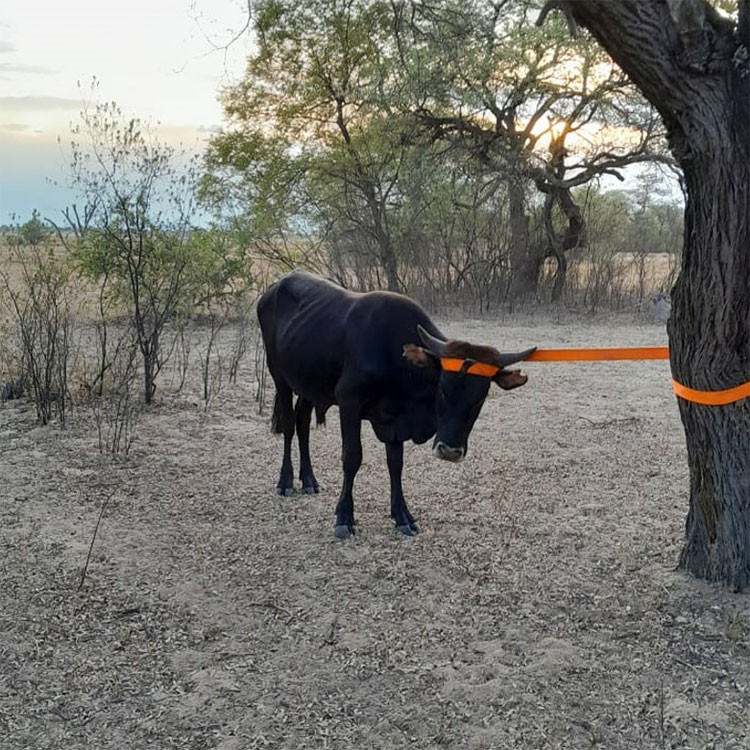
Documentary filmmaker Jonas Spriestersbach arrived just in time for the slaughter festival, he initially waned to make a documentary about the creation of the Herero Living Museum in Otjokavare. Whether this project will be realized now that we as LCFN withdrew due to lack of enthusiasm is anyone's guess. Nevertheless, he wanted to visit the project in Otjokavare, but decided to film the workshop because he was also very interested in this topic. We therefore made a swap deal and convinced the workshop participants to allow themselves to be filmed during the workshop. In return, Jonas will create a short documentation about the workshop.
Late in the evening, the Mbunza women prepared cow meat with all sorts of other filling side dishes for all workshop participants and we fell into our tents, dead tired.
Monday, October 30, 2023 – Day 1
Early in the morning we picked up another trainer (master blacksmith Joseph Lumayi) from the neighboring village and took him to the Living Museum. Since he is already a bit old, he asked to be allowed to sleep at home, so he was picked up every morning and taken back to his village in the evening. Joseph also brought his apprentice with him. The fourth coach, Daniel Ndumba, traveled independently from Angola every morning. We welcomed all four trainers again and briefly discussed the next few days.
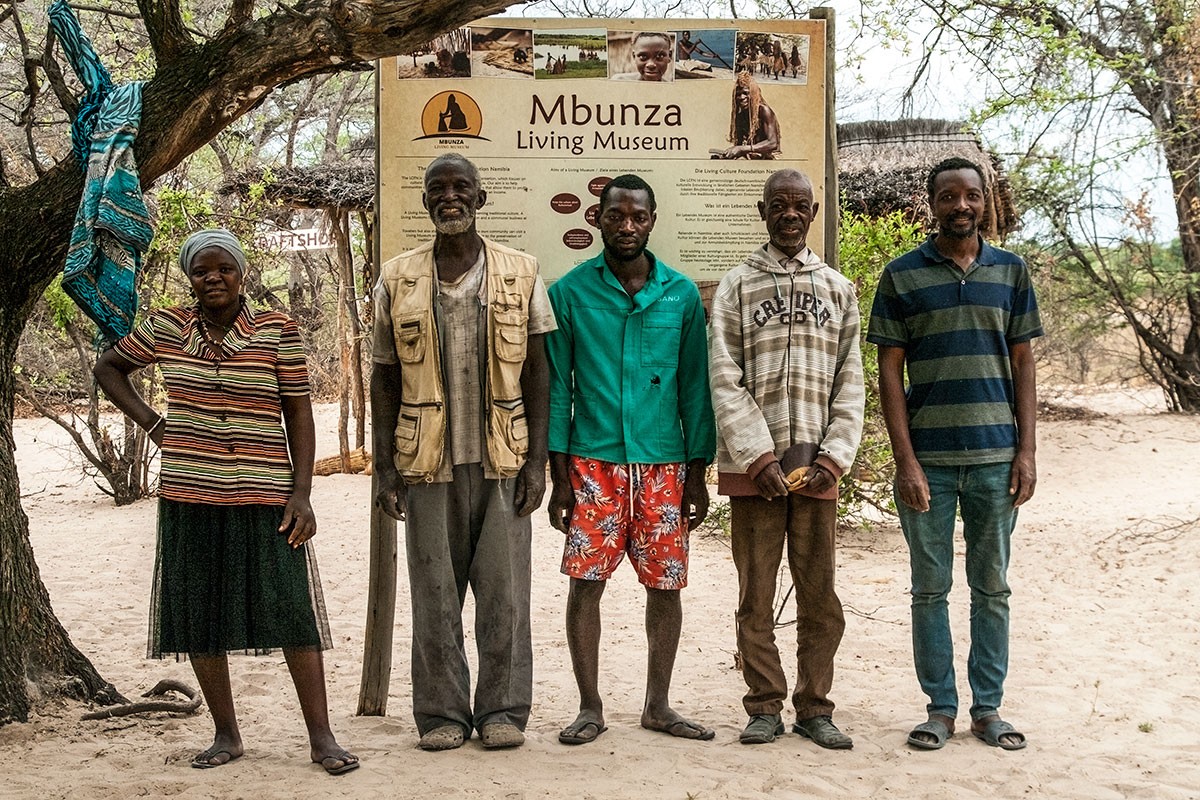
It was time for the official welcome and I gave a short speech to celebrate the day. After welcoming, I explained the concept of the workshop and focused primarily on explaining that all participants can participate in everything, but of course only the content relevant to their culture should be presented in their own museum. A pottery section in the Bushmen's Museum in Grashoek was not the purpose of the workshop.
The activities for the next two days were discussed. Enough tools should be made in the forge on the first day so that the next workshop days can run smoothly. Here especially knives and hatchets for the wood carving workshop, the tools for working on ostrich egg shells, and much more. For the women, the focus of the first day was on jewelry making and basket weaving. The clay for the pottery workshops still needs to be wet and prepared.
At the end of the official workshop opening, a catering committee was set up to report to us if something was running low and needed to be bought. The Mbunza women had also explained that all people in the workshop should take turns cooking.
Manager Sebron Ruben also reported that there was not nearly enough firewood and wood for the traditional carving workshop (and for spear making). So we drove with a few energetic Mbunza into the distant bush where the promoters of the Living Museum had received the right to cut wood from the Traditional Authority. After about 2.5 hours of chopping wood and digging through thick sand, we arrived back at the Living Museum and found that the workshop was now in full swing.
We had barely finished taking some photos of the activities when the catering people arrived and presented us with a long list of what was missing in the kitchen. So we decided to drive back to Rundu in the afternoon. We were also missing certain wrought iron, which we were supposed to get from the local garbage dump.
In Rundu, finding the “Rundu Scrap Yard” turned out to be a real challenge, as in this small industrial district every workshop, shop and garden looks like a garbage yard. We finally succeeded and purchased scrap iron that we hoped would be the right thing for the blacksmith workshop. We then drove to the wholesaler and bought supplies for the workshop.
Back at the Mbunza Living Museum a lot had already happened and we were pleased with the hard work of all workshop participants. The men had gathered around the three blacksmiths and the wood carver and were working on all kinds of tools. The women from all the museums sat together and the Ju/‘Hoansi from Grashoek and /Xa//oba explained to everyone what techniques there are for making jewelry from ostrich eggs.
The original plan was to hold a small music festival every evening, each hosted by a different Living Museum, but the workshop participants worked until after sunset and then had no energy left for making music and dancing. We discussed it with Sebron and decided on the last evening to shorten the workshop a little and organize the music festival here for everyone.
Tuesday, October 31, 2023 – Day 2
The focus of the men's workshop today was on further tool making in the blacksmith shop and wood carving. Trainer Elias Albert had asked all workshop participants to carve a crocodile following his instructions. The Mbunza and Mafwe in particular worked hard here, as the art of wood carving is deeply rooted in the culture of the two Bantu peoples. The other workshop participants also enjoyed the wood carving course.
The women began the pottery course today, which was particularly interesting for Mafwe, Mbunza and Damara, as these language groups had traditionally made pottery, but the skills have been lost and are therefore not or hardly used in the living museums. The Ovahimba, Khwe and Ju/‘Hoansi watched with interest, but continued with jewelry making and basket weaving for the time being.
In the afternoon some people complained of diarrhea and stomach pain and after further inquiries we learned that some of the beef had already spoiled the day before. Most of the slaughtered cattle went into a freezer box at Camp Samsitu and unfortunately we only now found out that this didn't really work. We got an idea of the situation and looked into the freezer - absolutely inedible, at least for European stomachs. We brought the still relatively good parts of the cow to the workshop and told the catering department that it had to be cooked very well. The even bigger problem was that the sugar had run out. We had bought two 10kg bags and thought they would be enough for a few days. Kathrin did the math quickly. 125 grams of sugar per person per day. The other food was also used up. We scheduled a meeting for the next day at which we wanted to talk about the food situation, because we also didn't have an unlimited budget for food.
Except for these problems, the workshop went wonderfully on the second day. Today's workshop day was remarkable not only for the progress made, but also for the friendships that emerged, as we see again and again. The people from the different museums exchanged ideas about their experiences working in the museum, wanted to know things about the other living museums and reported on their experiences. In a mix of 6 local languages (Fwe, Rukwangali, Otjiherero, Damara, Ju/'hoan, Khwedam) as well as English and Afrikaans, it wasn't always easy to stay on track with the content, but our feeling about the matter was very positive. People joked, laughed and yet worked with great concentration. The women had made many necklaces, bracelets and some baskets, as well as a number of pots of various shapes and uses.
Wednesday, November 1st, 2023 – Day 3
In the morning we had a meeting with all workshop participants in which we announced that the food needed to be organized better for the workshop. We also addressed the sugar problem, and even though there was no more sugar, people were still in a good mood. Sebron had organized a goat for the evening, so meat was on the menu again! For the next workshop we plan to give out the food every day.
We then organized a photo shoot with all participants. This was one of the humorous highlights of the workshop. The participants had a lot of fun photographing themselves in different constellations and groupings and then immediately uploading the photos to their WhatsApp status messages.
The activities for the next two days were then discussed. The wood carving course was supplemented by carving an elephant and a giraffe; the blacksmiths wanted to make spears and larger knives, as well as particularly hard forged iron rings for cutting flint. In addition to pottery and jewelry making, women also focused on tanning skins. All living museums were able to learn from Ju/‘Hoansi and Ovahimba.
In the afternoon we drove to Mobola Lodge to visit our friend Alex, a short weekend for us!
Thursday, November 2nd, 2023 – Day 4
In the morning we set off again to Rundu, we had already received a new shopping list from Sebron, so we stopped again in the capital of the Kavango and loaded the car with all kinds of food. As a little surprise and as a thank you for the last few days, we bought chicken for tonight, one of the Namibians' favorite dishes.
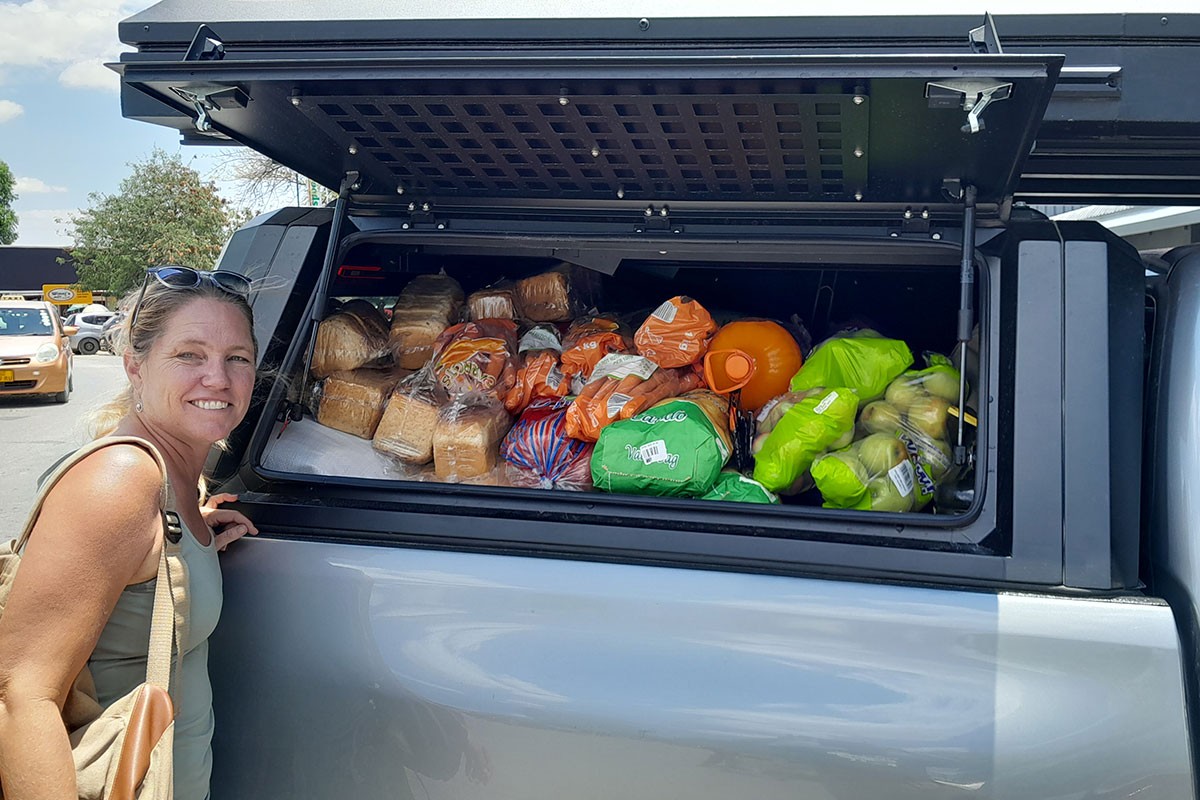
When we arrived at the museum, we noticed that the workshop participants were in a good mood and had worked hard as always.
The men had made traditional spears of very good quality and carved an elephant. The carving of animals may seem insignificant or trivial in the context of the complex cultural work in the living museums, but the men worked on it with real dedication. One reason for this is probably that if you master the art of carving, you can sell the work as souvenirs in the craft shops. Some of the carved wooden animals looked adorable.
The women had progressed well with the pottery course. Each of the women, including the Ju/‘Hoansi, who actually have no cultural connection to pottery at all, were allowed to try their hand at pottery and make some pots under the guidance of trainer Magdalena. The jewelry making workshop also continued. Meanwhile, each of the women who took part was able to process ostrich eggs in their sleep.
We stayed at the workshop until sunset and then said goodbye until the next day.
Friday, November 3rd, 2023 – Day 5
We arrived at the workshop early in the morning and organized a quick meeting with the participants. The activities had to be completed by around 4pm today. In the evening there was to be a closing ceremony at which certificates were to be presented to the participants. The whole workshop should then end with a small music festival.
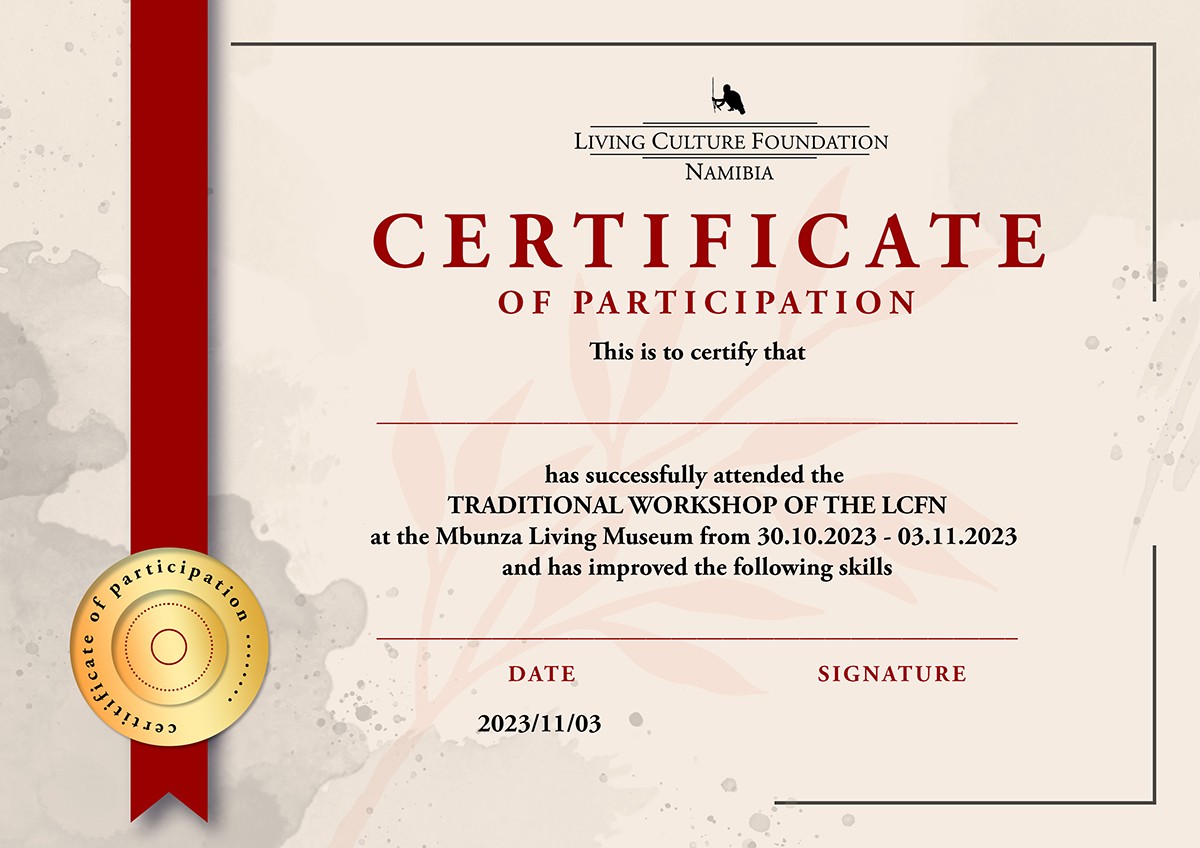
There was still a lot to prepare, for example the certificates had to be filled out.
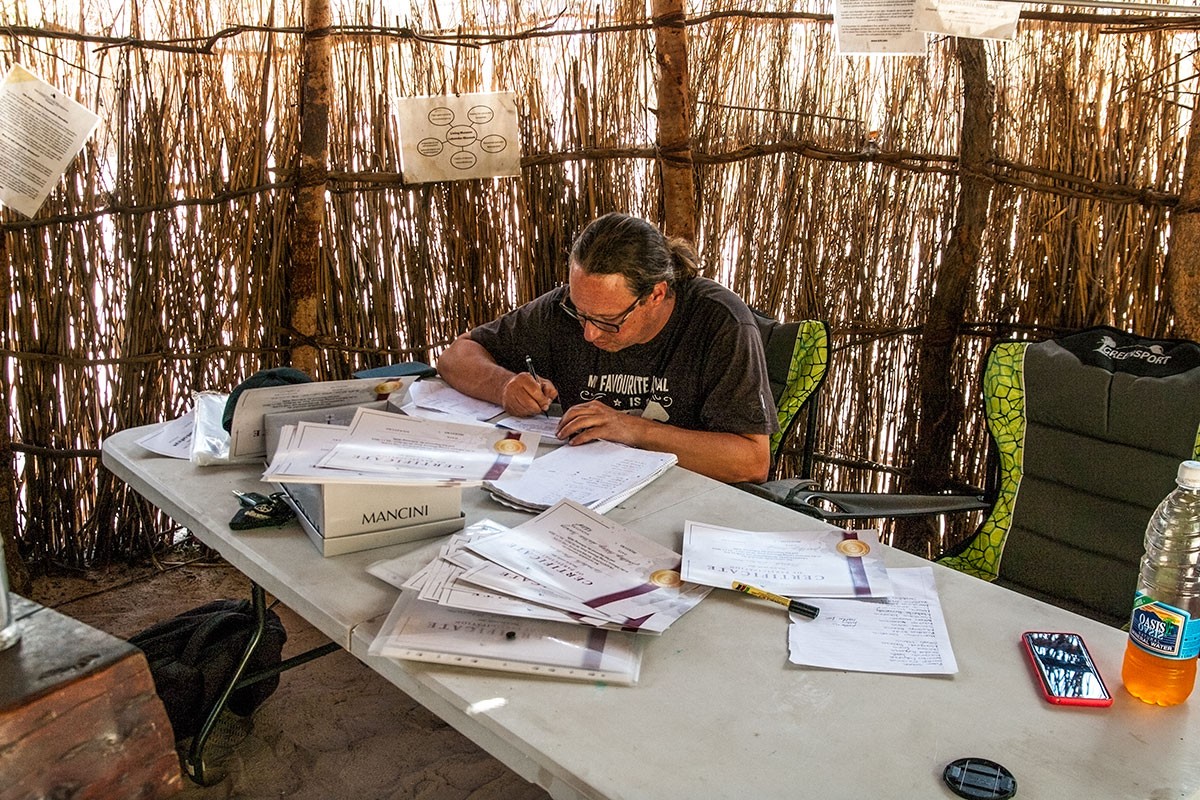
Elsewhere the workshop continued happily.
Certificates and closing ceremony
At last it was time. At the beginning of the closing ceremony, we thanked all participants and especially the Mbunza and manager Sebron Ruben for allowing us to use the Mbunza Museum as a workshop location. We explained again the importance of this type of cultural and intercultural workshops.
The certificates were distributed to all groups. It was Sebron who first gave us the idea of distributing certificates. We hadn't realized how important this could be for the workshop participants. When we finally distributed the certificates, there was great joy and enthusiasm.
The music and culture festival then began.
The Damara group started off by showing some of their dances to the workshop participants.
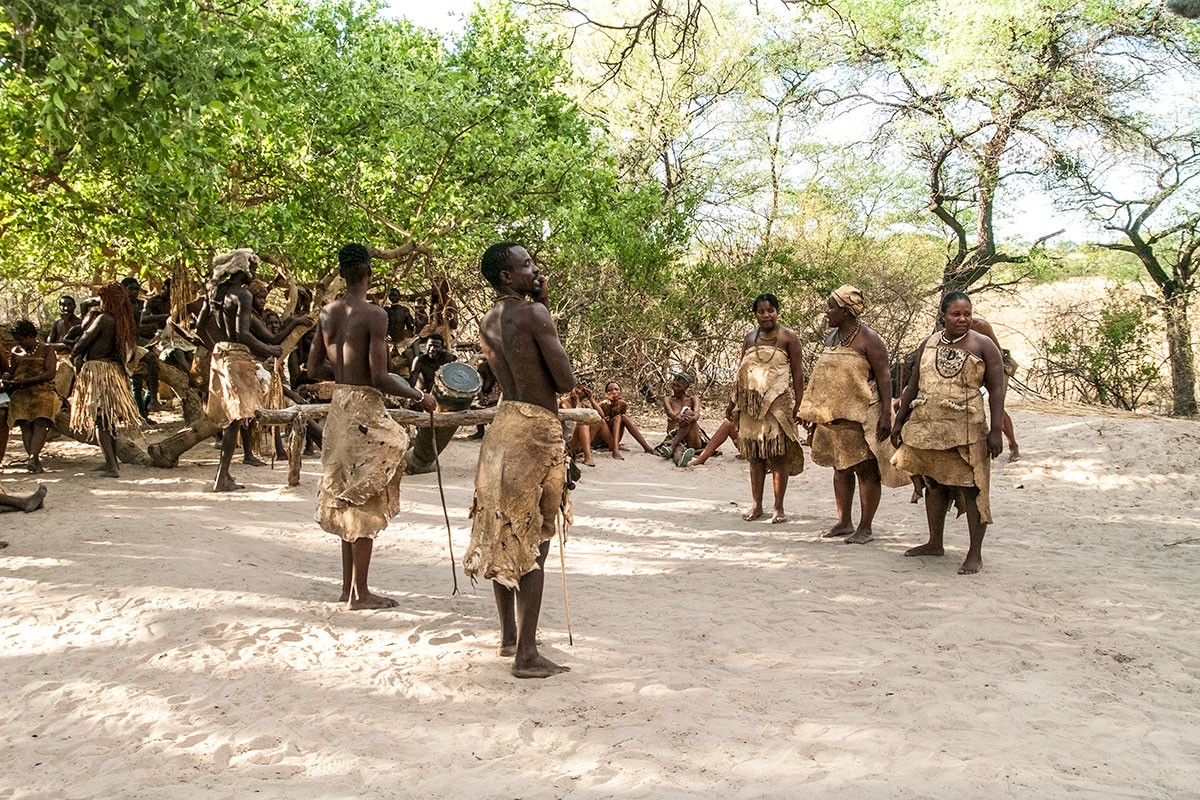
Afterwards - one of the early highlights of the music festival for everyone involved - the Ju/'Hoansi from Grashoek and /Xa//oba put in a great effort and thrilled everyone with traditional fire lighting and several trance dances.
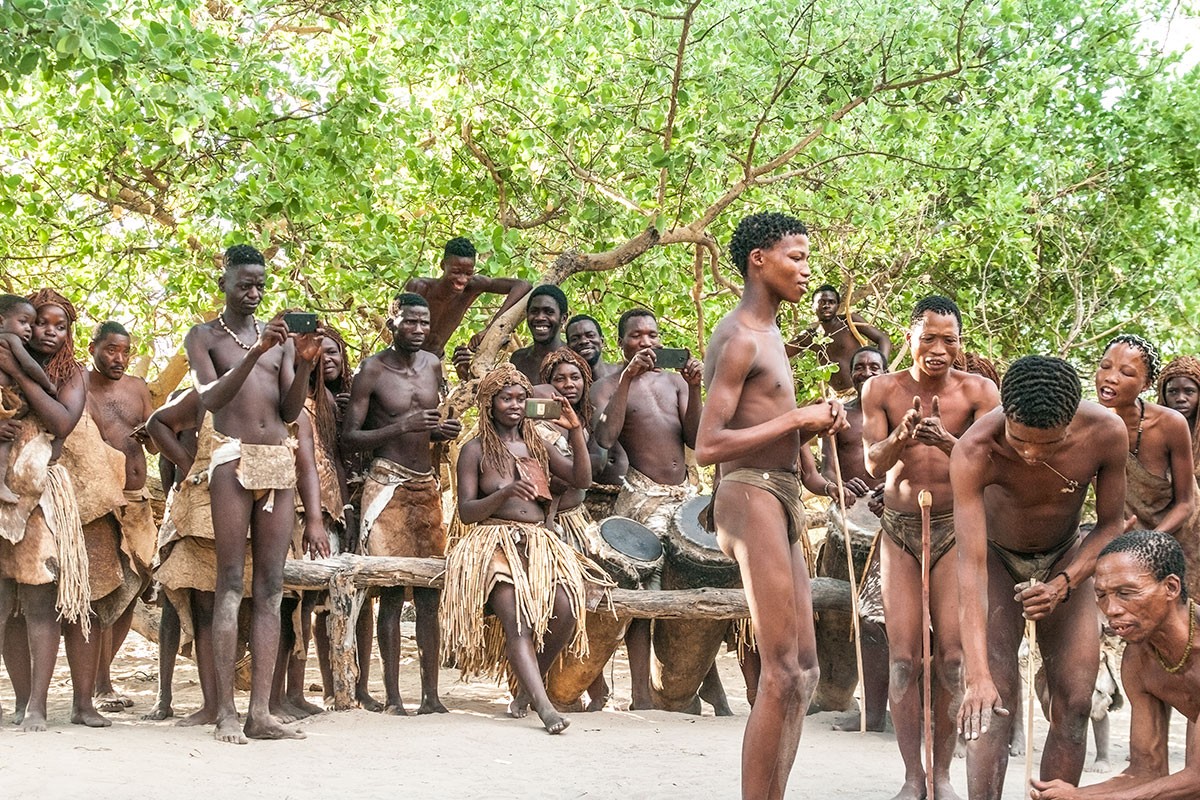
The Khwe then impressed with a mixture of storytelling, fire-making and a medicine dance.
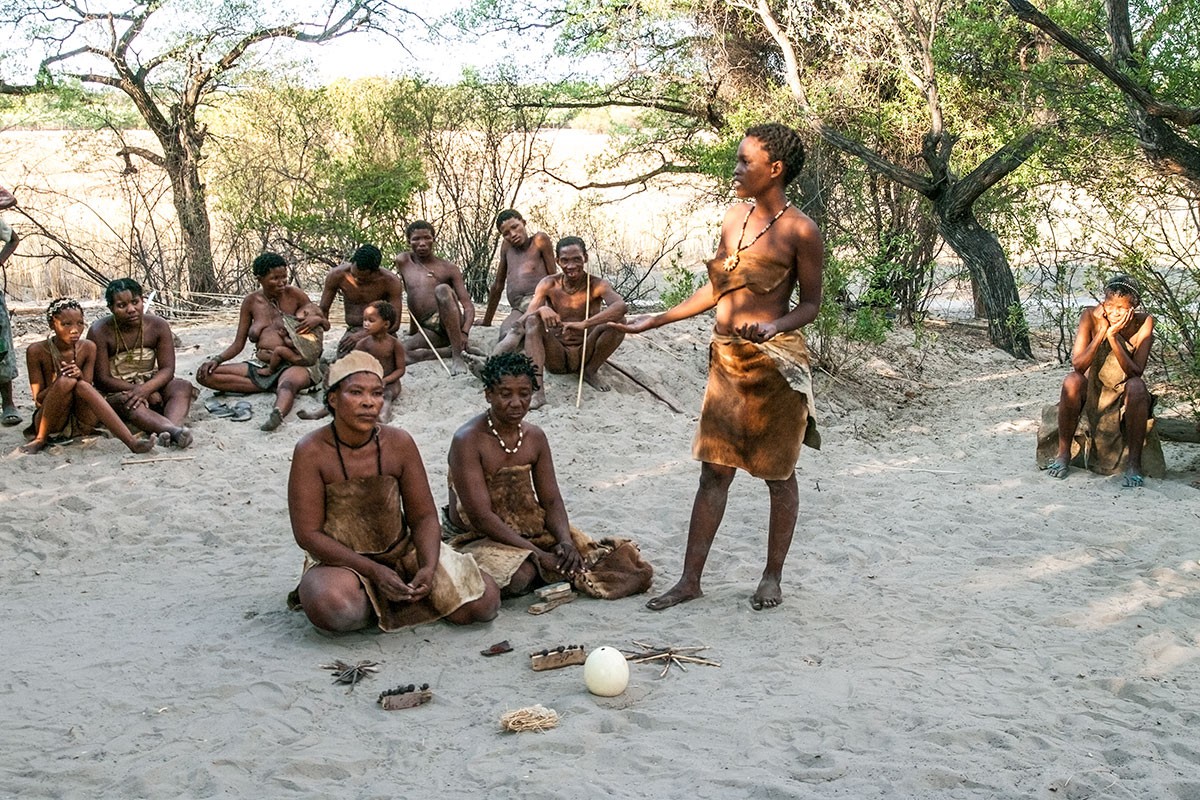
Afterwards, the Mafwe from Caprivi delivered a captivating performance with their typical dances and games.
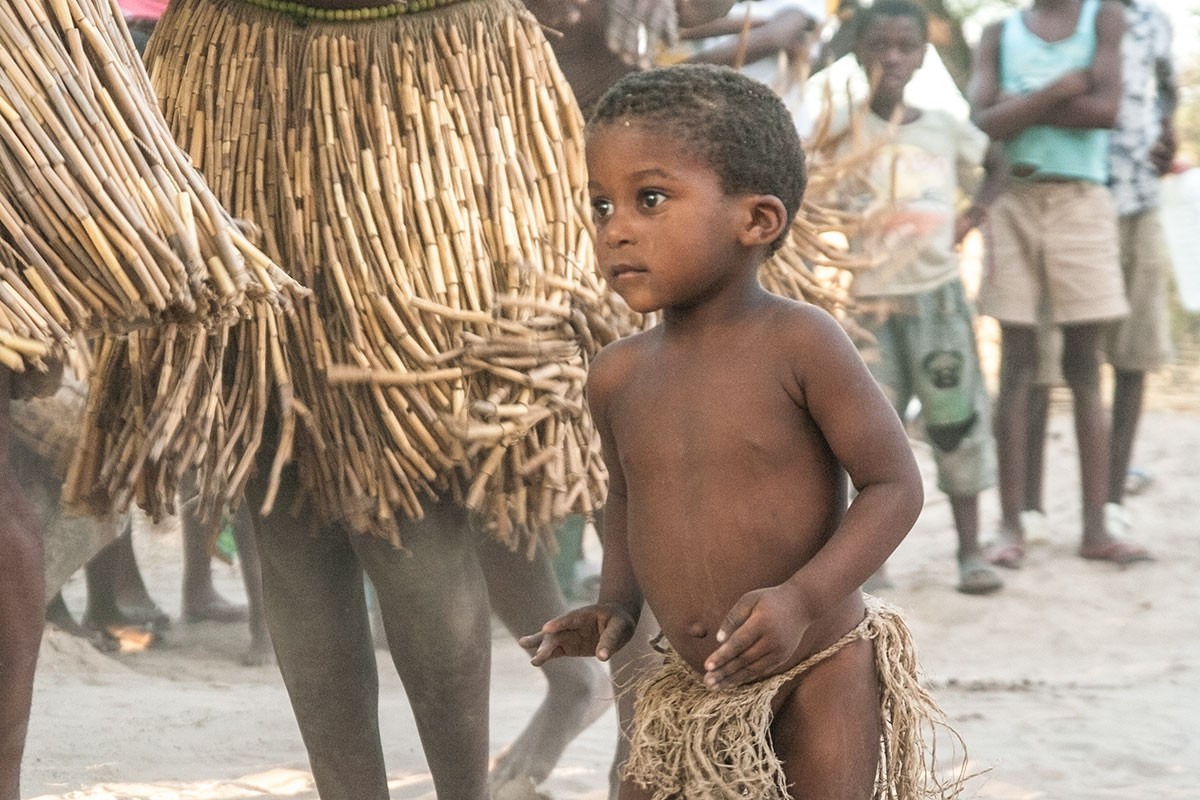
The Ovahimba were also able to inspire with their performance afterwards. After a hesitant beginning, it developed into an ecstatic dance.
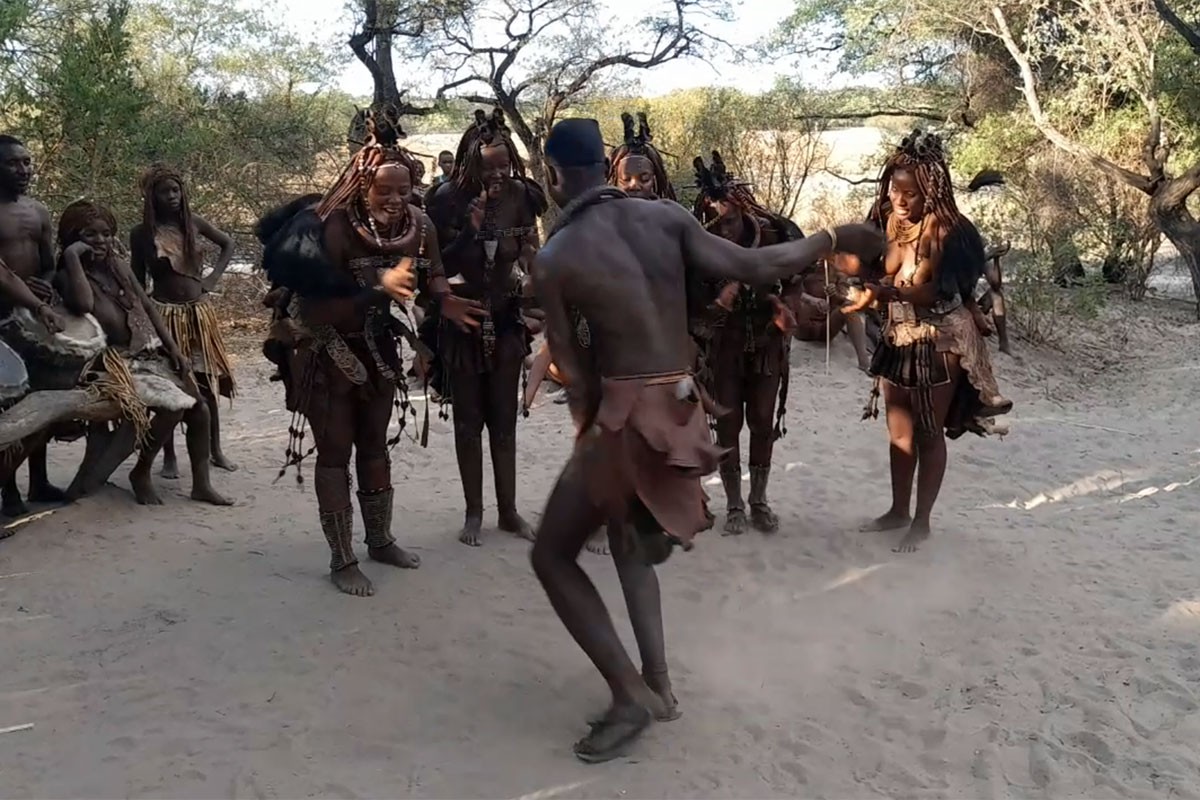
The highlight of the music festival was the captivating, and for us organizers, emotional performance by Mbunza. The group knew how to inspire the members of the other living museums so much that in the end people from all seven museums took part in the dance performance, so that you could hardly see anything because of the dust that was kicked in the air.
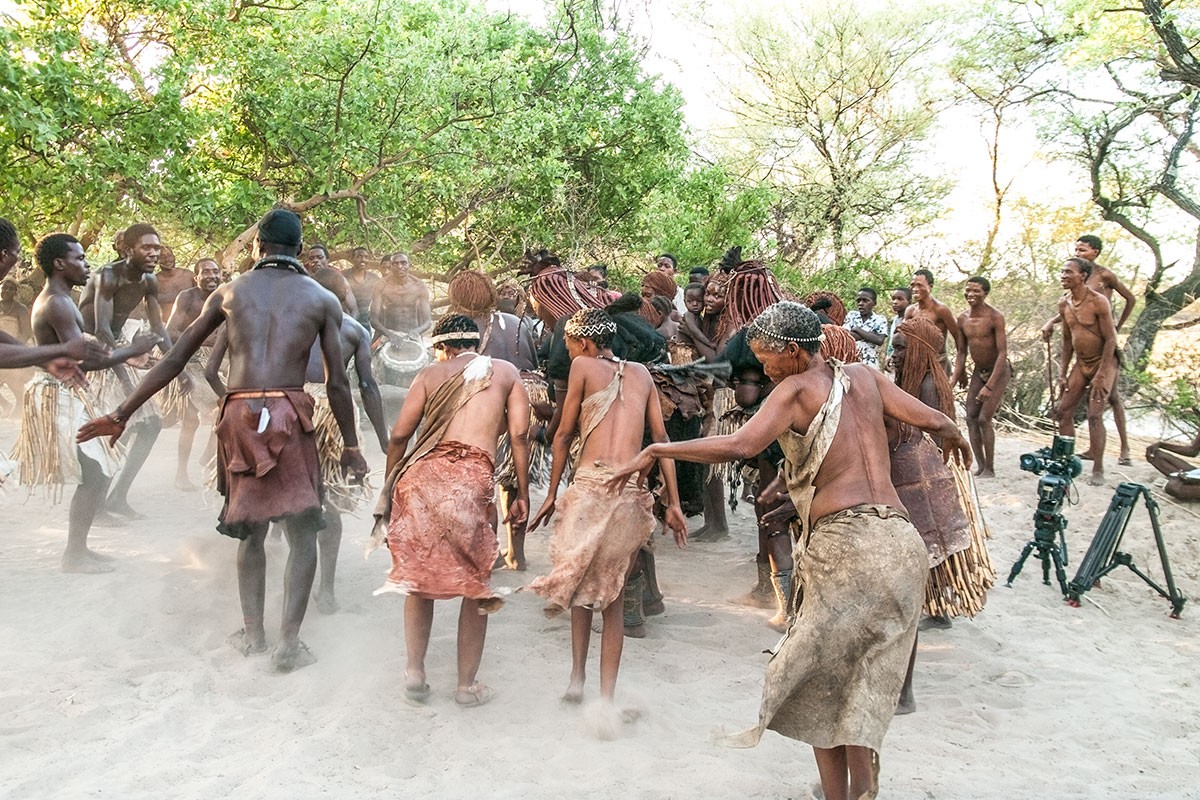
After the music festival - a really successful conclusion to the workshop - we drove to the camp happy and somewhat exhausted.
Saturday, November 4th, 2023 – departure day
After we had dismantled our camp, we drove back to the Mbunza Museum early in the morning and said goodbye to all participants. We took a few group photos with the workshop people and the things they made.
We then drove towards Windhoek with the two trainers we had brought with us from the surrounding area at the beginning of the workshop.
Conclusion
In our opinion, the workshop was a complete success, not only in terms of the traditional craftsmanship but also the intercultural approach.
The goals of the workshop, i.e. to improve traditional techniques and relearn lost techniques, were achieved primarily in the following craft areas.
- Blacksmithing
- Wood carving
- Traditional fire making
- Pottery
- Making jewelry from ostrich eggshells
- Fur processing and leather tanning
The workshop also contributed to intercultural exchange. New contacts were made, existing friendships were expanded and the wealth of experience that the museum employees had was shared with other project sponsors.
This achieved the following goals of our organization Living Culture Foundation and the German association Living Culture Namibia e.V.:
- Preservation and transmission of traditional culture: The LCFN promotes Namibia's traditional cultures. The local population is encouraged to engage deeply with their traditional culture in order to preserve or regain parts of their cultural identity.
- Creation of a cultural and intercultural educational institution: Not only the living museums themselves, but also the cultural and intercultural workshops contribute to achieving rapprochement and promoting tolerance within the Namibian population groups.
For us workshop organizers, the week-long traditional workshop was also an emotional event. We look with great joy and pride at the people who have been working in the Living Museums for almost 20 years (Grashoek was founded in 2004). Seeing how people from six different ethnic groups in Namibia have a common ground through their work in the Living Museums and how they worked together within the workshop is moving for us and gives a lot of energy for future projects.
Project report by Sebastian Dürrschmidt
When you subscribe to the blog, we will send you an e-mail when there are new updates on the site so you wouldn't miss them.



















